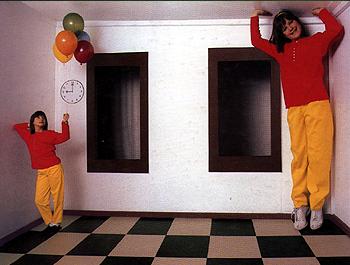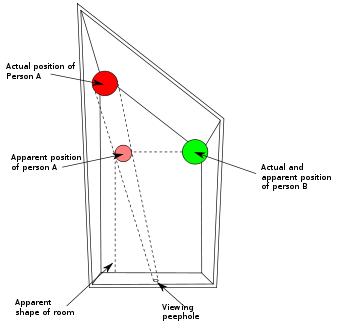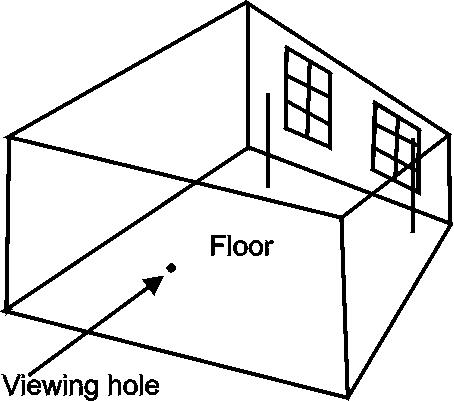The Ames Room Illusion
By Grant Ocean
Introduction
The Ames Room illusion is supposedly caused by the distorted room, seen in the picture below,
which is named after the
American ophthalmologist Adelbert Ames, Jr., who first constructed such a room
in 1935. He based his design on a concept originally conceived by Hermann
Helmholtz in the late 19th century.
In this illusion an object
standing at one end of the room looks like a giant (as shown by
the girl on the right in the picture below), while the other object at
another end (which is about twice farther away) looks very small (the
girl on the left in the
picture below; but actually they are twins),
but their depth is supposed to look the
same.
The illusion is deemed to be incredibly convincing so that a person
moving from the far corner to the closer one seems to be growing while
walking from the left corner to the right and conversely seems to be shrinking when walking from the
right corner to the left.

The reason for the illusion is usually stated this way:
An Ames room is constructed in such a way that from the front, it appears to be an
ordinary rectangular room, with a back wall and two parallel side walls
perpendicular to the horizontally level floor and ceiling;
but the true shape of the room is
trapezoidal, in which the walls are slanted and the ceiling and floor are at an incline,
and the right corner is much closer to the front-positioned observer than the
left corner (and vice versa), as shown in the two diagrams below.
Observers look through a viewing peephole into the room to
create the best viewpoint and supposedly remove any sense of depth created by viewing the
room with both eyes.
The illusion leads the viewers to believe that the two individuals are standing
in the same depth of field, when in reality one subject is standing much closer than the other.
The girl on the right in the image above appears at a much greater visual angle,
but the fact that she appears to be at the same depth of field as the figure on
the left makes the closer individual look much larger.


The generally accepted
explanation for the illusion is that for the image we see through the
viewing hole is identical to that which would be received from a normal
rectangular room;
however, when people stand in the room
there is a conflict.
The person in the far corner has a smaller image, due
to their greater distance from the observer as compared to a person in the
near corner. Observers see the people distorted in
size and the room retains its rectangular shape, presumably because we are used
to seeing rectangular not trapezoidal rooms.
Thus, an adult in the further
corner will appear smaller than a child in the nearer corner.
Ames and
subsequent researchers used this phenomenon to demonstrate the importance of
experience in perception. We
favor the mistaken perception of a normal room and wrongly see the people as
different sizes.
In other words, the Ames Room illusion is somehow caused by the
strange shape of the room; the apparently cubic perspective overrides your
perception of size constancy.
When looking at the Ames Room,
there are two illusions that are supposedly being
experienced. The first illusion is a result of looking through a special viewing
point with one eye and a stationary head. Looking through this viewing peephole removes
any cues from stereopsis and makes the room appear normal and cubic although
it's shape is actually trapezoidal; and
the floor is actually on an incline and the
walls are slanted outward.
The true shape of the room can be seen when not
viewing the room through the peephole or when looking at it from a top view, shown by the diagram on the left above. The
second illusion is that objects in the room appear to shrink or grow depending
on where they move in the room.
This special shape of the room is thought to remove all
distance cues and to not allow for proper scaling of object size. A
consequence of this is that we see people or objects as the same size as their
retinal images.
References
Kaufman, L. & Rock, I. (1962). The moon illusion I. Science, 136, 1023-1031.
Broerse J. et al. (1992). The apparent shape of afterimages in the Ames room. Perception, 21(2): 261-8.
Related Information on the Web:
http://en.wikipedia.org/wiki/Ames_room
http://www.psychologie.tu-dresden.de/i1/kaw/diverses%20Material/www.illusionworks.com/html/ames_room.html
http://psychology.about.com/od/sensationandperception/ig/Optical-Illusions/Ames-Room-Illusion.htm
http://www.newworldencyclopedia.org/entry/Ames_room
Appendix A: The Perceived Size and Its Mathematical Equations



